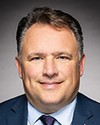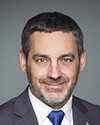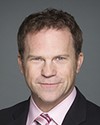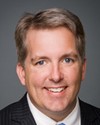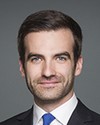Thank you.
Good afternoon, ladies and gentlemen.
It is a great pleasure to be here today to talk about our wonderful paralympic team and the Paralympic Games in London.
We had an exceptional experience two years ago in Vancouver at our home games in 2010. That really provided the foundation for us to prepare for the London 2012 Paralympic Summer Games.
Recognizing the gap between Olympic and Paralympic funding at that time, the Government of Canada affirmed $5 million in the March 4, 2010 federal budget to the Canadian Paralympic Committee for five years. The two main purposes are to invest in our Canadian Paralympic team and high performance through to the Toronto 2015 Parapan Am Games and to increase participation of Canadians with a physical disability in sport and recreation.
CPC is unique among national multi-sport organizations in that we not only manage Canada's national team, but we also create a sport system for people with a physical disability. We undertake the recruitment of athletes and encourage people with physical disabilities to participate in sport and recreation.
That was kind of a set-up for who we are. Now let me tell you about London.
Two great things happened in London that will impact Canadians and our strategy moving forward. These two things were on the field of play and off the field of play. Both are critically important to our future. The London Paralympic Games marked a new era in Paralympic competition.
In London we saw more countries competing at the Paralympics than ever before. In fact, 164 countries took part, up from 146 in Beijing four years earlier. World records were broken at an incredible rate at the London Paralympic Games. No less than 251 world records were set. To give you a comparison, by contrast the London Olympic Games set 27 world records during their two weeks of competition.
Countries around the world are investing unprecedented resources in Paralympic sport and it is showing in the medal count.
We are very proud of our athletes’ accomplishments.
Canadian athletes earned a total of 31 medals at the London Paralympic Games: 7 gold, 15 silver, and 9 bronze. This is a fantastic performance given the ultra-competitive climate of the Paralympic sport. To put this into context for you, in Beijing in 2008, we earned 50 medals including 19 gold.
As a result we did not achieve our very ambitious target for London, which was to place in the top eight in gold medal count. Our final ranking was 20th in the gold medal count and we ranked 13th in the overall medal count, which is exactly the same as our Olympic counterparts.
We are grateful for the Government of Canada funding and we are judicious in our use of it. London showed us, though, that medals do indeed cost money. The leading nations invest significantly more in their Paralympic programs than Canada does. Countries like China, Korea, Russia, Ukraine, Spain, Britain were ahead of us in medal counts and they invest many times what we do.
As proud Canadians, we are determined to fight back, to continue to use every dollar and resource we have to propel Canada forward. We're determined to regain our top 10 status at the summer games. The winter games in Sochi are a little more than a year away. We are targeted to finish in the top three, the same as in Vancouver, and we will get there.
The world is changing in Paralympic sport and we need to change with it. Building podium potential athletes takes years of investment. This is a long-term commitment.
What this means for Canada, especially as a G-8 nation and as a country considered to be one of the best places in the world in which to live, is that we must continue to work on building a more robust parasport Paralympic system, so that we can once again become a Paralympic leading nation. We are investing in the critical areas of athlete recruitment, development, and retention as well as supporting our coaches through further education and training.
While our business is sport, we invest in people. There are 4.4 million Canadians with a physical disability. The other 30 million Canadians are inspired by our athletes' incredible performances. We invest in communities. We invest in health, in fitness, in diversity, accessibility, and inclusion. These are all landmarks of Canadian values, I believe.
To achieve this, CPC has made a commitment to match the Government of Canada's investment with private sector funds. I am pleased to report to you that we are approximately two years into our funding and ahead of schedule to match those dollars from the private sector.
We agree that all Canadians have the right to enjoy the benefits of physical activity. We know that sport not only builds great athletes, but it also builds great people. Here is our other challenge, and this is what I think is really important and what we must pay attention to: only 3% of Canadians with a physical disability are currently active in organized sport compared to 30% of the general population. We are driven to change this at the Canadian Paralympic Committee. It is unacceptable. It is not good for the health and well-being of our nation.
To encourage more people with a disability to get involved in sport, we launched, during the London Paralympic Games, on national television in Canada, a campaign called “It's more than sport”, so that more Canadians will experience first-hand the many benefits of an active lifestyle.
For Canada to have a podium full of medallists, we also have to have a playground full of kids. We need to ensure that children with a disability know that they, too, deserve the right to play and to be physically active. We've also invested in equipment and programming grants in communities across the country. We hold parasport festivals in every province and territory, where people can come and try out different Paralympic activities. Our thriving schools program sends our Canadian Paralympic athletes to classrooms and gymnasiums to motivate students. Our athletes have personally connected with over 300,000 young Canadians in the last couple of years under this new funding.
Our Paralympian stories are being heard. They are empowering, motivating, and encouraging to all Canadians. Our athletes give back constantly and generously by speaking and appearing at schools, communities, hospitals, and service clubs, to mention a few.
In London, if the first great advance in the Paralympic movement was on the field of play with a rising tide of athletic performances, the second giant leap was off the field of play. It was a leap in public awareness, social change, and empowerment. A record 2.7 million tickets were sold for the games in London, with most events and sessions selling out. This is unprecedented internationally.
It is regarded as the family games. Why? It's affordable, it's accessible, and it's inspirational. England's channel 4 broadcast the Paralympic Games live in prime time all day and all evening, for 15 hours each day. Thanks to the games a generation has been inspired, empowered, and changed. The perception of people with a disability has changed, especially in Britain. Post-game studies show the positive impact of London 2012.
Here in Canada we had unprecedented growth in our traditional media coverage and social media activity around London.
In fact, there are over one billion Canadian media impressions of the London 2012 Canadian Paralympic team which was more than three times the amount of our Vancouver coverage. However, in stark contrast to the Olympic Games broadcast, coverage in Canada of the Paralympic Games was limited to one hour late at night, and it was hard to find. I know because I received hundreds and hundreds of letters from Canadians who were, I might say, royally annoyed by that coverage.
Canadians are telling us that they want more Paralympic games on television and they want them more readily available online. I need your support today to ensure that every Canadian has the opportunity to watch Paralympic athletes and Paralympic games in the future, on television and on their computers. From playground to podium, we are working with our sports partners to build a stronger parasport system in Canada.
We recognize that systemic change is not going to happen overnight. Developing a robust sports system takes time and will require a long commitment from all partners, such as my colleague, Anne, at Own the Podium, Sport Canada, Canadian sports centres, national sports organizations, the government, and corporate Canada. The investment from the Government of Canada has paid huge dividends. Our athletes and coaches are grateful. We are asking for renewed and increased investments post-2015, and I guarantee that CPC will continue to match any government investment with corporate partner funding.
Our London 2012 results confirmed the importance of CPC's strategic objectives of raising awareness, enhancing recruitment, a sport system alignment for people with physical disabilities, and embedding Paralympic sport within Canadian high performance. Our objective is to produce a sustainable Paralympic podium performance.
This is what is required for Canada to regain and maintain a position among the top 10 nations in the summer Paralympic medal standings. Finding and nurturing that next generation of Paralympic champions is one of our most urgent tasks. It's one that we're embracing with enthusiasm and energy, with passion and pride. In doing so, our Paralympians are inspiring all Canadians to dream of excellence, to never give up, and to be their best.
Together we will succeed. We are Team Canada.
We are proud to be Team Canada, and we thank you.

